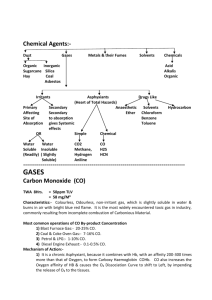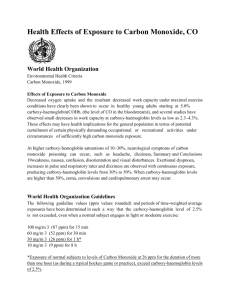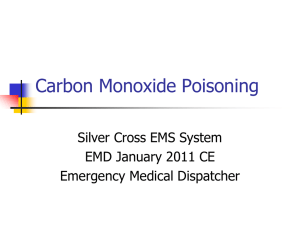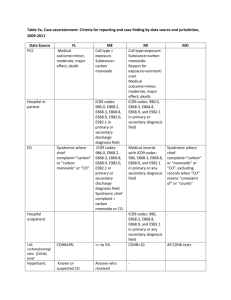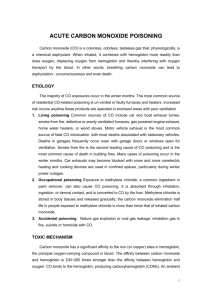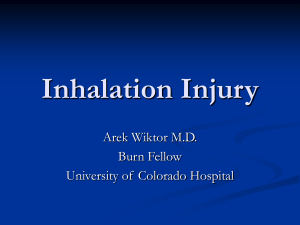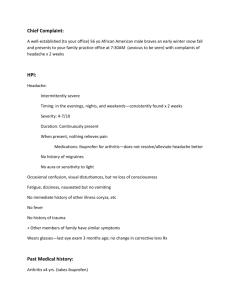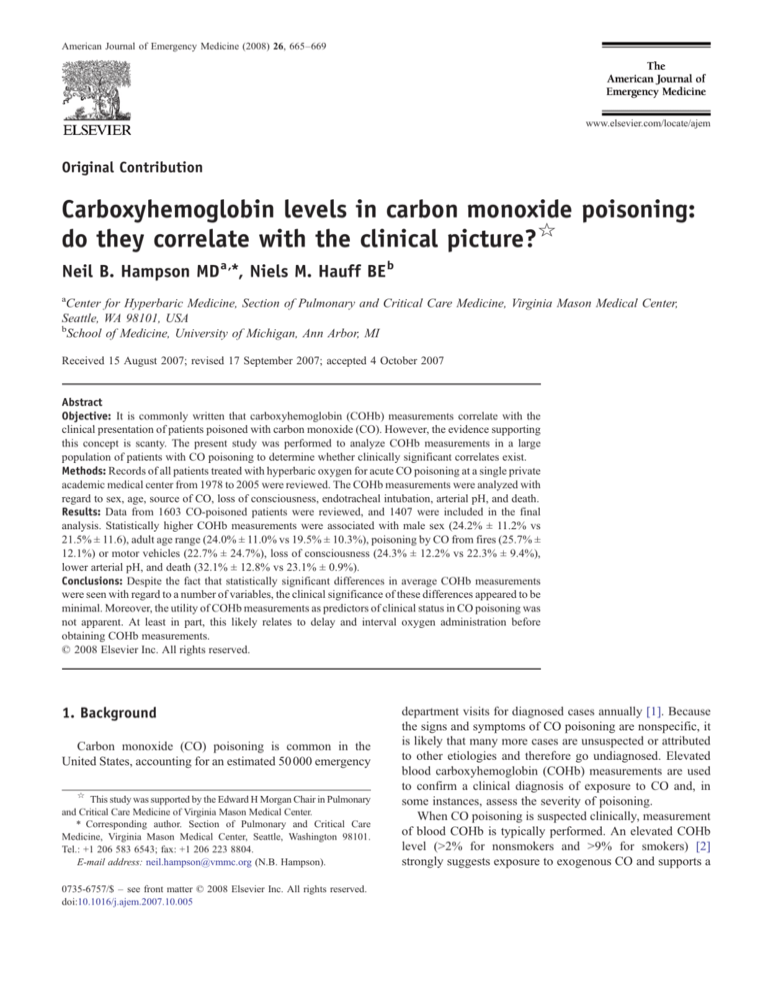
American Journal of Emergency Medicine (2008) 26, 665–669
www.elsevier.com/locate/ajem
Original Contribution
Carboxyhemoglobin levels in carbon monoxide poisoning:
do they correlate with the clinical picture?☆
Neil B. Hampson MD a,⁎, Niels M. Hauff BE b
a
Center for Hyperbaric Medicine, Section of Pulmonary and Critical Care Medicine, Virginia Mason Medical Center,
Seattle, WA 98101, USA
b
School of Medicine, University of Michigan, Ann Arbor, MI
Received 15 August 2007; revised 17 September 2007; accepted 4 October 2007
Abstract
Objective: It is commonly written that carboxyhemoglobin (COHb) measurements correlate with the
clinical presentation of patients poisoned with carbon monoxide (CO). However, the evidence supporting
this concept is scanty. The present study was performed to analyze COHb measurements in a large
population of patients with CO poisoning to determine whether clinically significant correlates exist.
Methods: Records of all patients treated with hyperbaric oxygen for acute CO poisoning at a single private
academic medical center from 1978 to 2005 were reviewed. The COHb measurements were analyzed with
regard to sex, age, source of CO, loss of consciousness, endotracheal intubation, arterial pH, and death.
Results: Data from 1603 CO-poisoned patients were reviewed, and 1407 were included in the final
analysis. Statistically higher COHb measurements were associated with male sex (24.2% ± 11.2% vs
21.5% ± 11.6), adult age range (24.0% ± 11.0% vs 19.5% ± 10.3%), poisoning by CO from fires (25.7% ±
12.1%) or motor vehicles (22.7% ± 24.7%), loss of consciousness (24.3% ± 12.2% vs 22.3% ± 9.4%),
lower arterial pH, and death (32.1% ± 12.8% vs 23.1% ± 0.9%).
Conclusions: Despite the fact that statistically significant differences in average COHb measurements
were seen with regard to a number of variables, the clinical significance of these differences appeared to be
minimal. Moreover, the utility of COHb measurements as predictors of clinical status in CO poisoning was
not apparent. At least in part, this likely relates to delay and interval oxygen administration before
obtaining COHb measurements.
© 2008 Elsevier Inc. All rights reserved.
1. Background
Carbon monoxide (CO) poisoning is common in the
United States, accounting for an estimated 50 000 emergency
☆
This study was supported by the Edward H Morgan Chair in Pulmonary
and Critical Care Medicine of Virginia Mason Medical Center.
⁎ Corresponding author. Section of Pulmonary and Critical Care
Medicine, Virginia Mason Medical Center, Seattle, Washington 98101.
Tel.: +1 206 583 6543; fax: +1 206 223 8804.
E-mail address: neil.hampson@vmmc.org (N.B. Hampson).
0735-6757/$ – see front matter © 2008 Elsevier Inc. All rights reserved.
doi:10.1016/j.ajem.2007.10.005
department visits for diagnosed cases annually [1]. Because
the signs and symptoms of CO poisoning are nonspecific, it
is likely that many more cases are unsuspected or attributed
to other etiologies and therefore go undiagnosed. Elevated
blood carboxyhemoglobin (COHb) measurements are used
to confirm a clinical diagnosis of exposure to CO and, in
some instances, assess the severity of poisoning.
When CO poisoning is suspected clinically, measurement
of blood COHb is typically performed. An elevated COHb
level (N2% for nonsmokers and N9% for smokers) [2]
strongly suggests exposure to exogenous CO and supports a
666
clinical diagnosis of CO poisoning. Many feel that the degree
of elevation of COHb level does not correlate well with the
patient's presenting clinical picture and do not use it to direct
management. In his review article on the diagnosis and
treatment of CO poisoning, Piantadosi wrote, “In general,
however, the correlation between clinical deficits and
measured COHb level is quite weak” [3]. The Undersea
and Hyperbaric Medical Society recommends hyperbaric
oxygen therapy for CO-poisoned individuals based upon the
clinical severity of illness irrespective of the degree of
elevation of their COHb measurements [4].
On the other hand, many articles on CO poisoning contain
tables or charts relating degree of COHb elevation to specific
symptoms or signs and the severity of the poisoning episode.
In their review article on clinical CO poisoning, Ilano and
Raffin wrote, “…in general, the severity of the observed
symptoms correlates roughly with the observed levels of
COHb…” [5]. The Merck Manual Professional Edition states
that “Symptoms tend to correlate well with the patient's peak
blood carboxyhemoglobin levels” [6].
The predictability of symptoms and signs with specific
COHb measurements is clearly a matter of dispute. The
present study was conducted to review the clinical
characteristics of a large population of patients with acute
CO poisoning to determine whether the degree of elevation
of the blood COHb level has identifiable clinically significant correlates.
2. Methods
After approval by the institutional review board, records of
all patients treated with hyperbaric oxygen for acute CO
poisoning at a single medical center from 1978 to 2005 were
reviewed. They were identified, and basic information was
obtained about each through the use of an institutionally
approved database containing all CO-poisoned patients treated
in the facility since its inception. Additional information was
extracted when necessary from the patients' medical records.
A case was defined as an individual treated with HBO2
with a history of CO exposure, symptoms consistent with CO
poisoning, and an elevated blood COHb level (N2%). The
COHb measurements reported represent the initial measurement obtained, either during primary workup at an outside
facility or after referral to the Virginia Mason Medical
Center, resulting in a variable amount of time and oxygen
treatment between CO exposures and sampling of blood for
COHb measurement. Criteria used to advise hyperbaric
treatment of a patient with CO poisoning typically included
transient or prolonged unconsciousness, neurologic signs,
cardiovascular dysfunction, severe acidosis, or elevation of
COHb level to the range of 25%.
Demographic data including first and last name, middle
initial, date of birth (DOB), social security number (SSN),
sex, race/ethnicity, and intent and source of exposure were
N.B. Hampson, N.M. Hauff
extracted from the charts by the 2 authors using a standard
data collection tool. Also extracted were clinical data
including initial COHb level, initial arterial pH, history of
loss of consciousness (LOC), and presence of endotracheal
intubation during hyperbaric oxygen treatment.
Although it is recognized that presenting COHb measurements may be normal in CO-poisoned patients because of
delay in obtaining a blood sample after removal from the
source of exposure and/or interval oxygen administration,
patients with COHb measurements less than 2.0% were
excluded to ensure that all patients evaluated were indeed
exposed to CO.
An application was submitted to the National Center for
Health Statistics of the Centers for Disease Control and
Prevention to query the National Death Index (NDI) to
obtain mortality information about the patients. The NDI is a
central computerized index of death record information on
file in state vital statistics offices [7]. It is available to
investigators only for medical and health research. After
approval of an NDI application by the National Center for
Health Statistics, a space-delimited text file containing the
patients' demographic information including first and last
name, middle initial, SSN, DOB, sex, and race was
submitted according to NDI protocol. The NDI search
criteria specify that each patient record must contain at least
one of the following combinations of data items: (1) first and
last name and SSN, (2) first and last name and month and
year of birth, and (3) SSN and date of birth and sex. Patients
for whom neither SSN nor DOB could be obtained were
excluded from the study because of the inability to search for
their death information according to NDI criteria. By mid2007, search results were only available for the years 1979
through 2005, limiting analysis to patients who had been
treated through December 2005.
The mortality information obtained from the NDI Plus
search was used to identify individuals who died within 30
days of the date of treatment. Those deaths were attributed to
the CO poisoning episode for the purposes of this study.
Data analysis included summary statistics and linear
regression (MedCalc software Version 9.3.3.0 Mariakerke,
Belgium). In some analyses involving LOC, intentionally
exposed patients were excluded because of the potential for
coingestion of other substances, which might be confounding.
3. Results
From 1978 to 2005, a total of 1603 patients were treated
with hyperbaric oxygen for acute CO poisoning. Of those,
164 were excluded because their records did not contain an
initial documented COHb level greater than 2.0%. An
additional 32 patients were excluded because their records
contained insufficient demographic information to submit
to an NDI search. The study population thus included
1407 patients, representing 88% of the total treated.
Carboxyhemoglobin levels in CO poisoning
667
Most patients (66%) were male. The average age for the
included group was 35 ± 19 years (mean ± SD; range 0-92
years). Intent of poisoning was accidental in 972 (69%),
intentional in 427 (30%), and indeterminate in 8.
Common sources of CO included motor vehicle exhaust,
567 (40%); fire, 174 (12%); indoor use of charcoal
briquettes, 158 (11%); furnaces, 85 (6%); boats, 84 (6%);
forklifts, 82 (6%); gasoline-powered electrical generators,
69 (5%); and propane-burning appliances, 64 (5%) (Table 3).
The COHb measurements for the study population and
various subgroups are shown in Table 1. Average COHb
level for the entire population was 22.3% ± 11.0% (mean ±
SD; range, 2.1%-72.3%). Measurements were slightly but
statistically significantly higher for male vs female patients,
adults vs pediatric patients (younger than 18 years), and
patients experiencing LOC vs those not. The COHb
measurements were also significantly higher among the
37 patients who died within 30 days of poisoning as
compared with those who survived. Of the decedents,
30 died within the first 72 hours after presentation. The
remaining 7 died from 7 to 28 days later.
Table 2 shows occurrence of LOC according to various
measurements of COHb in accidentally poisoned patients.
Occurrence of LOC was highest at the upper end of the
COHb range, but exceeded 40% at all ranges of COHb. Note
that 291 patients with intentional poisoning and LOC were
not included in this analysis for reasons previously stated.
Emergency department presenting arterial blood gas
analysis results were available from 823 patients (58%).
Arterial pH ranged from 6.70 to 7.71 (mean, 7.38 ± 0.11).
Table 1 Carboxyhemoglobin measurements for various
subgroups of patients
n
All patients
Male
Female
b18 y old
≥18 y old
Accidental
poisoning
Intentional
poisoning
Unknown intent
LOC
No LOC
Unknown
Endotracheal
intubation
Not intubated
Died (b30 d)
Survived (N30 d)
COHb %
COHb %
Mean ± SD (95% CI
of the mean)
Range
1407
922
485
228
1179
972
22.3 ± 11.0 (22.7-23.9)
24.2 ± 11.2 (23.5-24.9)
21.5 ± 11.6 (20.6-22.5)
19.5 ± 10.3 (18.2-20.8)
24.0 ± 11.0 (23.4-24.7)
22.8 ± 10.3 (22.2-23.4)
2.1-72.3
2.1-72.3
2.1-60.0
2.2-57.6
2.1-72.3
2.2-64.0
427
23.4 ± 12.4 (23.2-26.6)
2.1-72.3
24.3 ± 12.2 (23.3-25.1)
22.3 ± 9.4 (21.5-23.0)
2.1-72.3
2.2-61.0
24.8 ± 13.2 (23.0-26.3)
2.1-60.8
23.0 ± 10.5 (22.4-23.6)
32.1 ± 12.8 (27.9-36.4)
23.1 ± 10.9 (22.5-23.6)
2.2-72.3
3.0-60.0
2.1-72.3
8
745
661
1
247
1160
37
1370
CI indicates confidence interval.
Table 2 Incidence of LOC among 972 patients with
accidental CO poisoning and referred for hyperbaric oxygen
treatment, according to initial COHb measurement
COHb measurement (%)
Incidence of LOC
0-9
10-19
20-29
30-39
N40
55/116 (47%)
106/253 (42%)
167/381 (44%)
92/166 (55%)
39/56 (70%)
Fig. 1 demonstrates the relationship between initial arterial
pH and COHb measurements.
4. Discussion
Although this group of approximately 1500 patients only
represents a subset of the general CO-poisoned population,
their data make clear the fact that generalizations about the
relationship of COHb measurements to the clinical presentation of CO poisoning are likely to be inaccurate.
Indeed, COHb measurements were significantly associated with a number of demographic and clinical variables.
Measurements were statistically higher in male as compared
with female patients, adults as compared with children,
individuals experiencing LOC, individuals with lower arterial
pH, and individuals who died of their poisoning episode.
Blood COHb measurements were also higher in individuals
poisoned by exposure to CO from fires or motor vehicles.
However, the clinical significance of these statistically
significant differences is questionable. Although some
authors have written that symptoms and signs correlate
with COHb measurements, the current data would seem to
counter that concept. In the present study, clinical findings
that are objective and quantifiable were examined. Symptoms such as headache, nausea, or dizziness were not
extracted from chart review because of their subjective
nature and concern that their recording in the medical record
would be variable unless a standardized questionnaire had
been used.
On the other hand, LOC is an excellent sign to examine
with regard to relationship to COHb measurements. It is
obvious to observers when LOC occurs, and the occurrence
is likely to be recorded in the record when reported.
Although patients experiencing LOC had statistically
significantly higher COHb measurements on average, the
differences were trivial from a clinical standpoint (24.3% vs
22.3%). It is difficult to imagine a clinical setting where
differences of this magnitude could have any implications.
Furthermore, the overlap of COHb measurements in those
accidentally poisoned and experiencing or not experiencing
LOC extended over the entire range of measurements
(Table 1). Many patients who experienced LOC had
668
N.B. Hampson, N.M. Hauff
Fig. 1
Initial arterial pH versus initial carboxyhemoglobin (COHb) level in 824 patients with CO poisoning.
presenting COHb measurements less than 10%, and many
others who did not lose consciousness had measurements
greater than 50%.
In a typical table describing the relationship of symptoms
to COHb measurements, syncope is said to be “commonly
found” with measurements of 40% to 50% [5]. Among
accidentally poisoned patients in this study, the incidence of
LOC rose with COHb measurements greater than 30% and
rose further with measurements greater than 40% (Table 2).
However, LOC occurred with a frequency greater than 40%
at all measurements of COHb.
Analysis of arterial pH yields findings similar to those
seen with LOC. Although the correlation between increasing
COHb level and decreasing pH was significant (Fig. 1), it
would be impossible to predict the pH from the COHb level
in the clinical setting. Among patients with COHb measurements less than 20%, arterial pH ranged from 7.02 to 7.71.
Among patients with COHb measurements greater than 50%,
arterial pH ranged from 6.90 to 7.49. Metabolic acidosis is
known to result from impaired systemic oxygen delivery due
to COHb formation. The variation seen here is further
evidence that COHb formation is not the only mechanism of
CO toxicity and that other disturbances of cellular energy
metabolism may occur [3]. In addition, cardiovascular
dysfunction and seizure activity resulting from CO exposure
could play a role. A potential limitation is the lack of
availability of arterial PCO2 or serum bicarbonate in our
database. Although we presume that most acidosis is
metabolic in CO poisoning, a contribution of a respiratory
component is certainly possible.
Mortality was associated with the greatest absolute
differences in COHb measurements seen in this study.
Those who died had average COHb measurements approximately 50% higher than survivors (32.1% vs 23.1%). The
range of COHb measurements among individuals who died,
however, was wide and inconsistent with the concept that
there is a predictable level at which death occurs. Not only
did individuals die with initial measurements as low as 3%,
but the individual with the highest COHb level (72.3%)
survived. Death in patients with extremely low measurements is undoubtedly a function of delay in obtaining blood
after the exposure ends, as will be discussed. At the other
extreme, however, among the 27 individuals with measurements 50% or higher, 3 died and 24 survived. Although this
may be a higher rate of death than is seen at lower COHb
measurements, it is certainly not a useful predictor in the
individual clinical situation.
A limitation of the study is referral bias. This population
sample consists of those considered more seriously ill.
Because LOC and COHb measurements greater than 25%
were independent criterion for referral for hyperbaric
treatment, the population of those patients with LOC may
include more individuals with low COHb measurements than
normally occurs. Likewise, there may be excess representa-
Table 3 Carboxyhemoglobin measurements for major
sources of CO
Source
n
COHb %
Mean ± SD (95% CI
of the mean)
Boat
Charcoal
Fire
Forklift
Furnace
Generator
Motor vehicle
Propane appliance
81
148
174
82
85
69
567
65
23.3 ± 8.7 (21.0-26.3)
20.8 ± 9.0 (19.4-22.2)
25.7 ± 12.1 (23.9-27.5)
23.2 ± 8.4 (21.3-25.1)
21.2 ± 9.8 (19.1-23.3)
23.0 ± 10.6 (20.4-25.5)
23.7 ± 12.3 (22.7-24.7)
20.4 ± 8.9 (18.1-22.6)
COHb %
Range
3.3-42.7
3.0-57.0
2.3-57.6
3.4-47.3
2.2-42.3
6.6-49.7
2.1-72.3
4.1-42.4
Carboxyhemoglobin levels in CO poisoning
tion by individuals with minimal symptoms and marked
elevation of COHb measurements. These situations, however, serve to provide numerous examples contrary to the
commonly described relationships between COHb and
clinical presentation.
Because the differences in COHb measurements between
various groups are small, even when statistically significant,
and the comparative ranges of COHb measurements overlap
so greatly, one must agree with Piantadosi that measured
blood measurements correlate weakly with clinical deficits
[3]. It is probable that a major reason for this is the delay from
termination of the CO exposure to the time blood is drawn for
COHb measurement, as well as intervening administration of
oxygen. Both allow the COHb level to fall before blood is
obtained. Almost all patients had COHb measured at an
outside hospital before referral, but information was lacking as
to the time lapsed from removal from CO exposure to
obtaining blood. Although venous blood drawn into a
heparinized sample tube at the scene and transported with
the patient for subsequent analysis will remain stable even at
room temperature [8], this is not commonly done.
A handheld pulse CO oximeter was recently marketed
that allows rapid noninvasive measurement of COHb in
addition to conventional pulse oximetry variables [9]. When
first responders such as firefighter and emergency medical
technicians have this device readily available in the future, it
may be found that immediately measured COHb measurements correlate better with symptoms or signs because they
669
are closer to peak measurements. At present, it can simply be
said that although elevated COHb measurements are
indicative of CO exposure, they frequently do not correlate
with poisoning severity.
References
[1] Hampson NB, Weaver LK. Carbon monoxide poisoning: a new
incidence for an old disease. Undersea Hyperb Med 2007;34(3):163-7.
[2] Radford EP, Drizd TA. Blood carbon monoxide levels in persons
3-74 years of age: United States, 1976-80. Hyattsville, MD: US
Dept of Health and Human Services; Advance Data 76; March 17,
1982; 1982 [US Dept of Health and Human Services publication
PHS 82-1250].
[3] Piantadosi CA. Diagnosis and treatment of carbon monoxide poisoning.
Resp Care Clin N Am 1999;5(2):183-202.
[4] Feldmeier JJ. Hyperbaric oxygen 2003: indications and results: the
hyperbaric oxygen therapy committee report. Kensington, MD: Undersea and Hyperbaric Medical Society; 2003. p. 11-8.
[5] Ilano AL, Raffin TA. Management of carbon monoxide poisoning.
Chest 1990;97(1):165-9.
[6] The Merck Manuals Online Medical Library Web site. Carbon monoxide
poisoning. Available at http://www.merck.com/mmpe/sec21/ch326/
ch326e.html [Accessed June 20, 2007].
[7] National Center for Health Statistics Web site. National death index.
Available at http://www.cdc.gov/nchs/r&d/ndi/what_is_ndi.htm [Accessed
July 1, 2007].
[8] Hampson NB. Stability of carboxyhemoglobin in stored and mailed
blood samples. Am J Emerg Med 2007 [in press].
[9] Masimo Corporation Web site. Rad-57 pulse CO oximeter. Available at
http://www.masimo.com/rad-57/index.htm [Accessed July 1, 2007].

